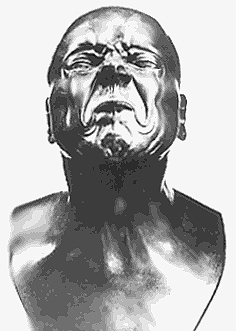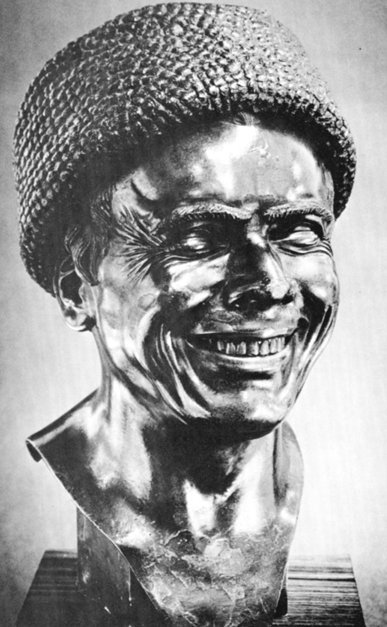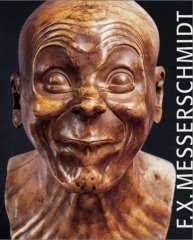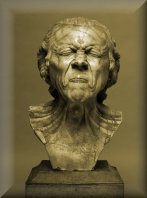





Purpose:
At the end of the year 2002 a major exhibit about Franz Xaver
Messerschmidt was held at the prestigious
Oesterreichische
Gallerie in the Lower Belvedere Baroque Museum in Vienna, Austria.
Some time after this show an English volume emerged:
Franz Xaver Messerschmidt, 
by Michael
Krapf, Maraike
Buckling
a beautifully photographed
production in hard cover available in German or English.
Very little other scholarly material has been written in English about
this remarkable artist and his time.
Herbert A. Ranharter, Berkeley, CA, has translated the definitive book about
Franz Xaver Messerschmidt
by Prof. Maria Poetzl Malikova: Franz
Xaver Messerschmidt,Verlag Jugend and Volk, Wien Muenchen, 1982
into English. The book will be available by fall 2010 as eBook
and CD publication.
These pages are posted to raise
awareness in the English speaking world and to seek a publisher for this book.
The translation is finished and was done in cooperation with the original author,
Frau Professor Maria Poetzl Malikova of the University of Bratislava.
Since the original publication, she has augmented the content with two new chapters
about recent discoveries, including the most recently found head of Franz Mesmer
(1734-1815), a German who found furtile refuge at the University of Vienna with
his dissertation "De planetarum influxu in corpus humanum De planetarum
influxu in corpus humanum", he also brought forth a theory of "animal magnetism".
She also adresses her recent discovery of the inventory lists of FXM's studio
that meticulously recorded what FXM had left after the sudden death of the artist
in 1784.
News note:
The Getty Museum of Los Angeles has recently acquired a Character Head by Franz Xaver Messerschmidt "The Vexed Man";
 the head will be back on exhibit
by late summer of 2010.
the head will be back on exhibit
by late summer of 2010.
Messerschmidt Book options map:
______________________________Original Book cover
______________________________Curriculum Vitae of the author Frau Professor Maria Poetzl Malikova
______________________________Curriculum Vitae of the translator Herb Ranharter
______________________________Sample Pages and statistics of the German publication
Introduction:




 Strolling
through the galleries of the Lower Belvedere in Vienna, Austria amidst
much art history, you chance upon some remarkable sculptures:
heads
of stone, bronze and wood made by Franz Xaver Messerschmidt. You are
faced
with sculpture that screams at you through time and perception. The
passion
screams with an immortal voice, free and alive in spite of the confines
of being eternally frozen. The works are not simply content to stun
with
superior craftsmanship; they transcend the limits of stone, bronze and
wood, blowing the envelope off the boundaries of convention and of time
itself. The works were outrageous in their time; they are outrageous
still.
They are the agonies and ecstasies of Franz Xaver Messerschmidt (FXM).
Strolling
through the galleries of the Lower Belvedere in Vienna, Austria amidst
much art history, you chance upon some remarkable sculptures:
heads
of stone, bronze and wood made by Franz Xaver Messerschmidt. You are
faced
with sculpture that screams at you through time and perception. The
passion
screams with an immortal voice, free and alive in spite of the confines
of being eternally frozen. The works are not simply content to stun
with
superior craftsmanship; they transcend the limits of stone, bronze and
wood, blowing the envelope off the boundaries of convention and of time
itself. The works were outrageous in their time; they are outrageous
still.
They are the agonies and ecstasies of Franz Xaver Messerschmidt (FXM).
Perspective:
The passions of FXM, his anger and frustration as well as his commercial
successes are now in the museums. Art politics and artistic integrity pinned
against the necessity to earn money: which side can anyone afford to be
on? How far must convictions be compromised? FXM knew who he wanted
to be and his choices landed him in trouble, his very nature dictated them.
Add to the frey the industrial revolution, when everybody had a new theory about
something, and everybody thought of coming up with something significant because
it was all of a sudden possible. FXM's stunning skills and stellar success colided
with his passions, leading to a multifaceted powerplay of politics and economics,
impackting his health. The outcome of the struggle became a turning point
in his career and became the subject of many interpretations, a detective story
with profound philosophical implications. "Nothing is ever simple"
thus this author has his own, new,, triforcated take on what happened to the
FXM story.
Observations and Speculation:
A significant obstacle to FXM's career in Vienna may well have been his love for art and his desire for truth and a bend towards humorous pranks. FXM had earned a faculty position at Vienna's Academy of Arts through his remarkable abilities. Yet the Academy did not keep it's promise because of FXM's refusal to conform. Messerschmidt's behavior was a threat to the Academy's politics all along. The Academy maintained it's power base by catering to the wishes of the aristocracy, which in turn rewarded the Academy with contracts and commissions. To deviate from the Academy's practices as a member of the faculty was political suicide. A health problem akin to a stroke which afflicted FXM for a spell served ultimately as rational for his elimination .
Mozart's struggle against the Viennese music establishment, as portrayed in Amadeus by Peter Shaffer, is a Zeitgeist parallel to FXM's struggle against the visual arts establishment. Mozart's masterpieces "Le Nozze Di Figaro" and "Don Giovanni" are revolutionary attacks against the unbridled powers of the aristocracy and institutions and as such, encountered strong opposition in Vienna. These stuggles reflected the fist ripples preceding a new order in the offing. The distribution of contracts for sculpture was in the hands of Academy functionaries and so was the fate of the faculty. FXM was deemed not to be a "politically correct" staff member. He would speak his mind in critique and refused to conform to established art conventions. He made many enemies among his peers and among the administration.
FXM's refusal to conform resulted in increased economic pressures.
When he finally had set up his own studio, the economic rug was pulled out from
under him by denying him the contracts he needed more than ever. Unbearable
economic and political pressures may well have resulted in the afore mentioned
brain affliction that shattered his career. There is speculation that
he may have suffered degrees of lead poisoning in the course of doing his work;
what is known is that he fell ill for a time. Rumors were spread of his insanity,
citing his sculptures and his general behavior as evidence. The image they conjured
up was used to deny him his promotion in the Academy. In the wake of these
accusations the commissions from royalty and wealthy clients dried up further;
Viennese high society was close knit and in fear of rebellion. Messerschmidt
never quite recuperated from his defeat in Vienna.


Conclusion:
It is unlikely that FXM aimed his "Character Heads" to ridicule
the aristocracy directly. It is much more likely that he meant to illustrate
his ideas about a system of physiological cause and effect having to do with
facial responses to body stimulation. None the less this author would argue
that there is an undeniable element of defiance in the "Character Heads"
when compared with the regal portraiture comissioned by the aristocracy perhaps
a suconsious desire may have convenieniently fallen into place. Mental illness
on part of FXM is equally unlikely, though such speculations keep surfacing.
No monolythic explaination will ever serve to sort out a complex life like FXM's
in a time and an environment that exploded with possibilities and challenges.
FXM's struggle is timeless. The academic art industry suffers a dearth
of funding and much of what is available comes as unearned gains. Money not
earned becomes the political capital of the successful manipulators. Fierce
power plays among the functionaries of the art institutions are commonplace.
Few in these settings dare to speak their mind; criticism is the supreme threat
to officials and affiliate artists alike. Order in the ranks is maintained
by channeling funds so as to preserve the status quo. What was true in the days
of FXM is true today: one might break the establishment and oneself, but one
will reform neither.
Herbert A. Ranharter
P.S.: "Non sub sole novum est"
"The dreamers ride against the men of action" (Leonard Cohen), against the party line, against all convention. When Akenaten committed such heresy in ancient Egypt some 4000 years ago he was ousted and retroactively erased, fiercely scraped away. History is made of such examples. It took the Vienna Secession movement in 1900 to put a major dent into the Vienna Academy and still, to this day, it is an elite institution of significant political clout.
© 2010 Herb Ranharter, All rights
reserved, All web rights reserved
Notes:
Lower Belvedere (Unteres Belvedere)
Museum
of Medieval Art and Baroque Museum, 3rd district,
Rennweg 6a
Tram 71: Unteres Belvedere
The Baroque Museum contains the world’s most
comprehensive
collection of works by Maulbertsch, Messerschmidt
and Donner
(among them, the original statues from the Donner
Fountain on
Neuer Markt). The Museum of Medieval Austrian Art
in the
Orangery of the Lower Belvedere features Romanesque
and Gothic
wood sculptures and altar panels, among them works
by Pacher
and Frueauf.
a brief chronology
1736 6th of February: baptized in Wiesensteig, Oberamt Geislingen, Württemberg, Germany; family of tanners; one of 32 siblings.
1746 7th of January: death of the father, removal to Munich. Apprenticeship at his uncle's Johann Baptist Straub (1704-1784), sculptor at the court.
~ 1752 Apprenticeship at his uncle Philipp Jakob Straub (1706-1774), sculptor at the court of Graz.
~ 1754 Moves to Vienna.
1755 4th of November: student at the Vienna Academy of Arts, Jakob Schletterer.
1759-70 Martin van Meytens, Director of the Academy, furthers Messerschmidt.
1760- Works for the royal court and high nobility, mostly portraits
1765 Stay in Rome
1769
22th of February: joins the Academy of Arts. -
2nd of March: joins the Academy of copperplate engravers (cf.
opinions,
Behr)
- 10th of September: nomination as a substitute professor with a right
to succeed Schletterer.
- Transition to classicism.
1770 March: buys a house and sets up studio at Ungargasse 5, neighbor of Mesmer. - 23rd of March Martin van Meytens dies. - Starts work on the heads.
1774 1st of March: sells the house and most of his art works. - 19th of May Schletterer dies. Messerschmidt's right of succession is passed over.
1775 5th of May: passport, travels to Munich and Wiesensteig, settles at Munich.
1777 August: moves to Preßburg/Bratislava, lives at his brother's, Johann Adam.- Works for citizens and the court.
1780 29th of December: buys a house in Preßburg's suburbia.
1783
August: death after short illness. Leaves 69 portrait heads.